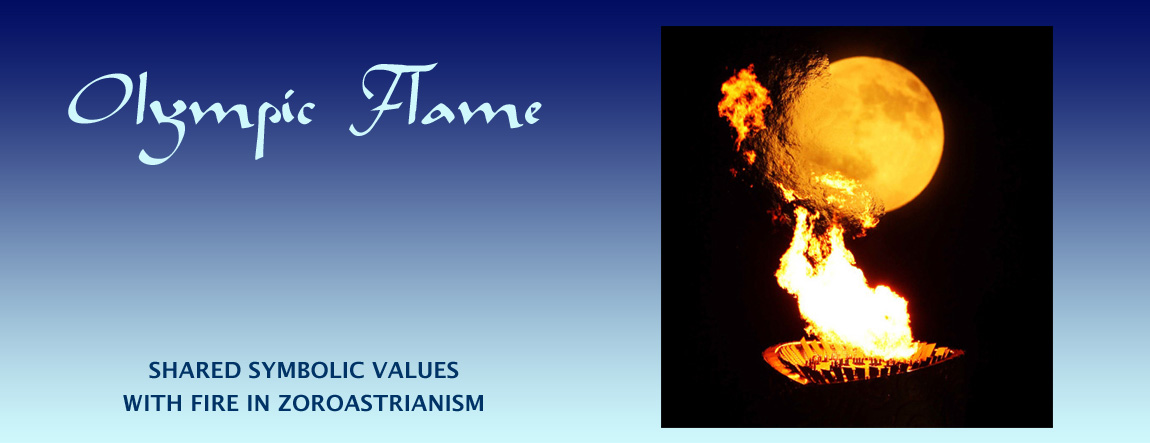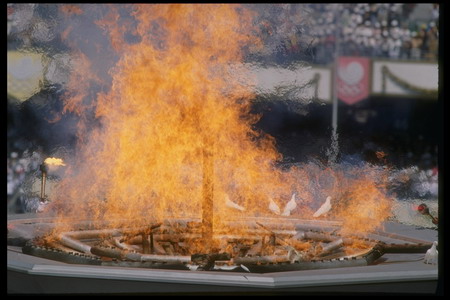Page 1. The Flame, Lighting of the Flame, Videos & Photographic Tour

Contents
|
Further reading:
Olympic & Zoroastrian Flames
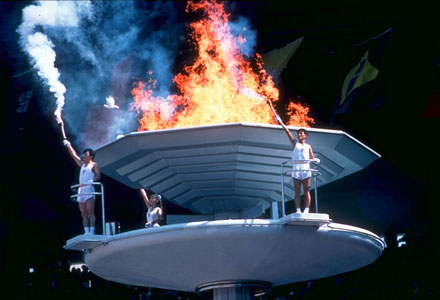
|
The flame just after its lighting at the 1988 Seoul, Korea Olympics.
Image credit: China.org |
Sacred Values
The Olympic flame is frequently referred to as "sacred" and the reverence shown to the flame is similar to the reverence shown by Zoroastrians to a fire that is part of a Zoroastrian worship ceremony.
While it is the values behind both flames that are at the core of their symbolism, the flames in and of themselves acquire an aura of sacredness, for to harm or sully the flames translates as harm to the values represented. This acquisition of an aura of sacredness is similar to the manner in which a nation's flag acquires an aura of sacredness. To desecrate a flag can cause great offense for it is not the cloth of the flag that is desecrated but everything the flag represents.
Symbolism
The symbolism of the eternal flame in Zoroastrianism can be compared to the symbolism of the Olympic flame - it symbolizes core ethical values and principles - as well as everything that Zoroastrianism and the Olympics respectively represent. The core values represented by both flames include honesty, fairness, good order and abiding by the rules of good order. Using fire as a symbol adds another dimension to the values, namely the spirit behind the values and how the values can be transmitted from one person to the next and eventually to an entire community.
The ritual of lighting the Olympic flame; the ritual observed in the transportation and installation of the flame; the care taken not to allow the flame to be extinguished until the end of the games; the reverence with which the flame is treated, as well as the awe the Olympic flame inspires, are all very Zoroastrian-like.
Lighting of the Olympic Flame

|
| Map of ancient Greece |
Games at Olympia - a Short History
The flame of the modern-day Olympic games is lit before each game at the site of an ancient temple-stadium complex in Olympia on the Peloponnese island of Greece. There are reported records that state that games were held at the site as far back as 776 BCE and held thereafter every four years. Other texts place the origin of the games in the 6th century BCE. Within the complex are the ruins of the goddess Hera's temple.
Deeming the games to be pagan in origin, either the Christian Roman emperor Theodosius I - known for his advocacy to annihilate the religion of the Greeks - or his grandson Theodosius II, abolished the games in 393 or 435 CE respectively.
The games were reintroduced in 1859 CE in Athens City Square with athletes from Greece and the Ottoman Empire participating. The first international games were planned by a newly constituted International Olympic Committee held from June 16 to June 23, 1894, at the Sorbonne University in Paris. On the last day of the Congress, it was decided that the first multinational Olympic Games would take place in 1896 in Athens.
Traditional Lighting of the Olympic Flame
Traditionally, the temple fires at the Olympia were "lit by the Sun on Mount Olympus*", home of the Greek Olympian gods and a few hundred kilometres north of Olympia, from where torch bearers carried the flame on foot to Olympia.
[* Mount Olympus is the highest mountain in Greece at 2,919 metres (9,570 feet) in height.]
Temples & Temple Fires At Olympia
The ancient Olympic games honoured the chief of the Olympian gods Zeus, who had a temple dedicated to him at Olympia. Fires were lit at his temple as well as the temple dedicated to his wife and sister, Hera. An ever-burning fire used to burn at the altar of hestia, the goddess and guardian of fire, whose temple was also located in Olympia. The fire altars of Zeus and Hera were open air altars while the fire altar of Hestia was indoors in a Prytaneum. The Prytaneum was also used for the large banquets held in honour of the athletes at the end of the games.
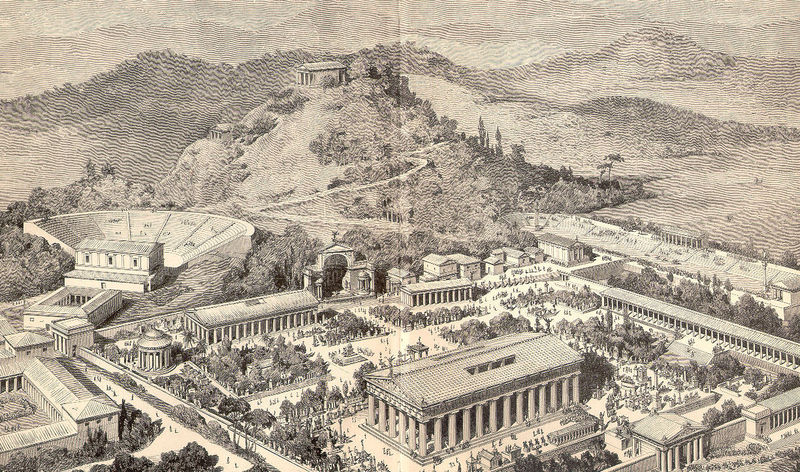
|
Artist's impression of ancient temple-stadium complex at Olympia. The stadium can be seen on the top right..
Source: Pierers Universal-Lexikon, 1891. Image credit: Immanuel Giel at Wikipedia |
Lighting of the Fire for the Games
The flame for the ancient games was lit at Olympia at the temple of Hera's outdoor altar and the games were held in a stadium adjacent to the temples. A receptacle called the skaphia served as a form of parabolic mirror and was used to start the fire for the games. The use of the sun's rays to start the fire ensured the purity of the fire and also obtained the fire from a source associated with the gods.
The fire for the Hestia temple's ever-burning fire was also obtained from the heat of the sun's rays, and was used to light the other fires of the sanctuary. This fire was available for lighting the torch for the games in the event that the sun was not available for lighting the game's fire.
Ancient Torch Relays
While fire played a prominent role in the rituals surrounding the ancient Olympic, there were no ancient Olympic relays since the fire was lit within the temple-stadium complex. However, there were torch races held annually from the Akademos to the Acropolis in Athens. In addition, a fire was carried from the sanctuary of Artemis Pyronia to Lerna.
In Athens, the torch races were called lampadedromia held on the night before the Panathenaea as part of a festival celebrating the Titanic god Prometheus' gift of fire (and consequently civilization) to humankind. The celebrations also honoured other gods such as the goddess Hestia, guardian of the hearth fire and goddess of peace. Prometheus' theft of the fire from Zeus and his race to give the fire to humans before the theft was discovered, is the prototype of the torch race. During the Athenian race, the flame was carried by competing runners and the first runner to arrive at the receiving altar had the honour of renewing its fire. Pausanias describes (1.30.2, tr. Jones) the ritual: "In the Academy is an altar to Prometheus, and from it they run to the city carrying burning torches. The contest is while running to keep the torch still alight." While Pausanias' account describes the race as one between individual runners, other accounts suggest that the race was run by a team of relay runners. Herodotus (8.98) compared the Persian postal messenger relays along the Royal Road to the torch races. Walter Burkert (1985, 227-34) surmised that the celebration marked the start of the new year in the month of Hecatombaion, the first month of the year that began with the first sighting of the new moon after the summer solstice (July-August of the Gregorian calendar).
[References:s:
» Prometheus By Carol Dougherty. Page 53-57.
» Prometheus: Archetypal Image of Human ExistenceBy Karl Kerényi, Ralph Manheim. Page 69-71.
» 7 Personification in the Greek World: From Antiquity to Byzantium Emma Stafford, Judith Herrin. Page 135-138.]
The modern Olympics bring together the fire lightning ceremonies, the torch races as a relay, and the athletic competitions of Olympia. Part of the symbolism of fire are the characteristics of the goddess Hestia, guardian of the fire: competitive but peaceful coexistence.
Truce & Peace During the Olympics
According to the Olympic Museum, "At a set time before the start of the ancient Olympic Games, messengers wearing olive crowns left Elis to announce in other cities the exact date of competitions. They invited the citizens to come to Olympia and proclaimed the sacred truce (ekecheiria), that is, the obligation to halt combats one month before and during the period of the Games. In this way, the athletes and spectators could travel without fear to Olympia and back home."
Modern Lighting of the Olympic Flame
The lighting of the flame and its transfer to a torch that will be carried to the host country's stadium is now an elaborate ceremony intended to replicate ancient customs.
The modern Olympic flame is ignited at the site where the temple of Hera used to stand. The altar where the Olympic flame is ignited at the temple of Hera is located opposite and to the east of the entrance which is to the right of the columns in the image below. Today, some stone slabs are all that remain of the altar.
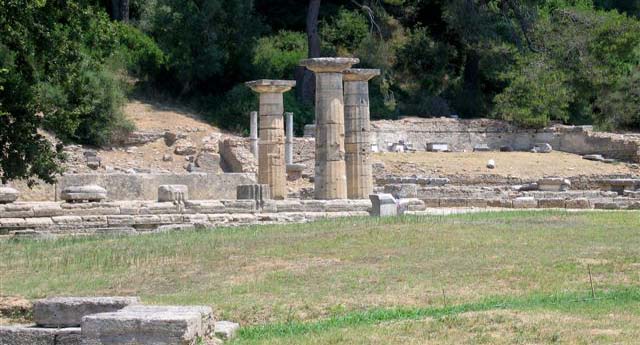
|
| Ruins of Hera's temple. Image credit: photographer unknown |
The fire is first lit using the sun's rays concentrated by a parabolic mirror. The sun's rays are used to ensure the purity of the fire and also to obtain the fire was a source considered to be divine. The parabolic mirror focuses the sun's rays on the head of a torch which is ignited by the heat of the concentrated rays. The fire from this initial torch is then transferred to an urn. In order to plan for the possibility that the skies may be overcast on the appointed day and time for the lighting ceremony, a fire which has been ignited on a prior sunny day (and maintained) is used to light the fire in the urn.
 |
| The lighting of the torch using the sun's rays. Image credit: zacharo.com
|
|

|
Actress Maria Nafpliotou (at right) as the high priestess, lights the urn
in front of the ruins of goddess Hera's temple at Olympia on March 23, 2008
for the 2008 Beijing summer Olympics. Image credit: various. This image at Business Week |
 |
| The urn and fire |
|
As part of a procession, the priestess carries the urn from the fire altar at Hera's temple down to an altar in the ancient Olympia stadium where it used to light the first torch. She is accompanied by a young boy who plucks an olive branch from the grove. The individuals involved with the ceremony all wear white as is the custom with Zoroastrian ceremonies. The olive branch will be used to make a cotinos or Olympic victory wreath. When the procession arrives at the stadium, the fire urn is placed on the stadium altar where the priestess lights the first relay torch.
 |
The procession from Hera's temple to the stadium with boy holding an olive branch in the lead.
Image credit: various. life.com |
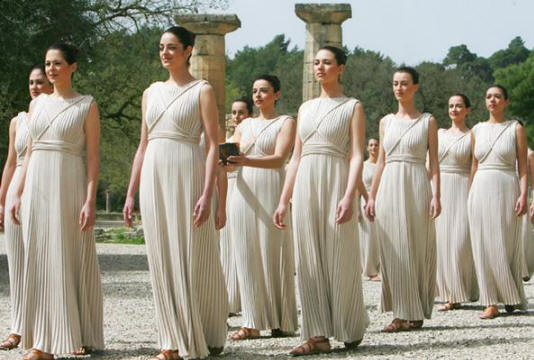 |
The high priestess carrying the flame in the procession
Image credit: various. smh & BBC China |
|
 |
The lighting of the first relay torch
Image credit: xooob.com
The torch will now be carried by relays of torch bearers as well as
different modes of transportation to the
Olympic stadium in the host nation where the games are to be held.
|
 |
Handing over the olive branch
Image credit: various. freeblog |
 |
| Releasing a white dove of peace |
|
Additional backup lanterns are also lit and maintained in case the torch flame is extinguished for any reason. It is considered a great honour to carry the flame and an even greater honour to be the person who lights the flame in the stadium's cauldron.
 |
| Torch runner enters Seoul stadium, 1988. Image credit: china.org.cn
|
 |
| Lighting the Seoul stadium's cauldron, 1988. Image credit: china.org.cn |
|
In the Olympic stadium is a cauldron, often placed at the top of a grand staircase, that will hold the fire until the end of the games. As part of the opening ceremonies, the final torch bearer ascends to the spot where the fire will be transferred to the cauldron and lights the cauldron's flame - a moment filled with inspiration and awe.
 |
| View of Seoul stadium from cauldron, 1988. Image credit: china.org.cn |
|
The cauldron is designed to keep the flame burning continuously and the flame is only extinguished after the games have closed.
Reference:
» Olympic.org - official Olympic website
» The Olympic Museum at Olympic.org - The Olympic flame and Torch Relay
Videos of Olympic Torch Lighting Ceremony
Videos of past Olympic Opening Ceremonies
Further reading:
|
